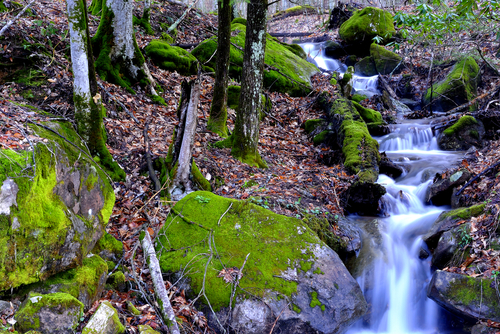The following study about how Pittsburgh’s aging sewers are spilling large amounts of nitrogen into local watersheds is not just an isolated a problem for the residents of Pittsburgh.
As Marion Divers, a principal author of the study, has pointed out: “You build a sewer system once, put it underground, and unless there’s a catastrophic failure, you may not have a reason to dig it up and make sure it’s not leaking. Now sewers across the United States and in Pittsburgh are aging, and as these systems grow older, more sewage is leaking into groundwater and streams.”

Spring, Rhododendron and stream, Monongahela National Forest, West Virginia, USA
Shutterstock
Current story for review:
Pittsburgh’s leaky faucet: How aging sewers are impacting urban watersheds
Aging sewer systems are spilling a considerable amount of nitrogen into urban watersheds, diminishing both the quality of water and ecosystems’ habitats. However, many studies documenting the impacts of nitrogen on urban environs have not properly estimated the contribution of leaky sewer systems—until now.
Aging sewer systems are spilling a considerable amount of nitrogen into urban watersheds, diminishing both the quality of water and the ecosystems’ habitats.
Using water samples from the Pittsburgh-based Nine Mile Run watershed, a Pitt research team reveals in the current issue of Environmental Science & Technology that an estimated 10 to 20 tons of reactive nitrogen from sewage flows into Pittsburgh’s Monongahela River every year from the six-square-mile watershed. That means that up to 12 percent of all sewage produced by residents living in the Nine Mile Run watershed area leaks from the sewers and is transferred to the stream, negatively affecting stream water quality.
“This is a very complicated problem,” said Marion Divers, principal author of the paper and a Pitt PhD candidate who conducted the study under the supervision of Pitt assistant professors of geology and planetary science Emily Elliott and Daniel Bain, who were coauthors of the paper. “You build a sewer system once, put it underground, and unless there’s a catastrophic failure, you may not have a reason to dig it up and make sure it’s not leaking. Now sewers across the United States and in Pittsburgh are aging, and as these systems grow older, more sewage is leaking into groundwater and streams.”
While living organisms need nitrogen to build essential proteins, leaky sewer systems, the burning of fossil fuels, and overuse of chemical fertilizers have contributed to an overabundance of nitrogen in U.S. rivers and streams. Too much nitrogen can deplete the water of oxygen, with results as threatening as those seen in the Gulf of Mexico Dead Zone, where marine life doesn’t have the oxygen necessary to live.
An estimated 10 to 20 tons of reactive nitrogen from sewage flows into Pittsburgh’s Monongahela River every year from the Nine Mile Run watershed.
“Leaky sewers are simply not something most people are interested in until they begin to smell it in the stream or see things like a particular fish disappear from the stream,” said Bain. “Based on the results from our Nine Mile Run study, this paper forces the wider urban ecology community to more carefully consider this sewage problem.”
In order to accurately measure nitrogen’s impact on Nine Mile Run, the Pitt team had to first determine how much was coming from leaky sewer systems. Over a two-year period, the researchers collected water samples biweekly from the small stream located in Pittsburgh’s East End during both rainy and dry time periods with intensive sampling during one summer storm. Nitrogen concentrations were measured in the samples, and the researchers used this data to estimate sewage contributions to nitrogen in the stream’s water. Notably, the results highlighted that sewers in this study basin are leaking consistently, even during dry weather conditions. While the apparent volumes of sewage are concerning, the study also reaffirms the substantial ability of urban systems to hold onto this nitrogen, despite the heavily impacted stream channel and the predominance of paved areas.
“This suggests a pervasive influence of leaking sewers—even during periods without rainfall. This is in addition to the raw sewage contributions during wet weather from combined sewer overflows that are currently the subject of mitigation efforts in Pittsburgh,” said Elliott. “Our report highlights the importance of assessing nitrogen leakage from sewers into our waterways, particularly as sewer systems age across the United States.”
Source: AAAS EurekAlert
Photo: Rhododendron and stream, Monongahela National Forest, WV from Shutterstock
[source: http://feeds.importantmedia.org/~r/IM-greenbuildingelements/~3/0MkWS4lIo18/]

Leave a Reply
You must be logged in to post a comment.